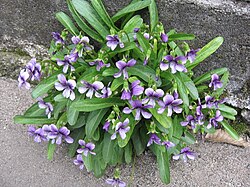en
names in breadcrumbs


Viola mandshurica is a perennial species of violet known by the common names dōng běi jǐn cài (zh:东北堇菜) meaning 'northeastern violet' in China, jebikkot (ko:제비꽃) meaning 'sparrow flower' in Korea, and sumire (ja:菫, ja:スミレ) meaning 'violet' in Japan. In Japan, V. mandshurica is considered to be the basic species and other violet species have additional descriptors such as himesumire or nojisumire. Its specific name is derived from Manchuria, an area of its native habitat which has at different times in history included parts of modern China, Korea, Mongolia and the Russian Far East.
It is native to eastern Asia, being found as far west as eastern Siberia, throughout China, Taiwan and Korea, north into Russian North Asia (particularly in and around the Ussuri River Basin), and in much of Japan, including Okinawa. Across its range, this species occurs in a variety of habitats, from undisturbed woodlands to urban areas, and from low-lying plains to mountainous regions. A number of varieties have been developed by horticulturalists and are popular as garden plants. The wild form, and most named varieties and hybrids, prefer a semi-shaded location and humus-enriched soil that is not overly moist.
Viola mandshurica, like many other viola species, does not have a true stem, with leaves and flowers each emerging directly from the ground (actually from its underground rhizome). Its rhizomatous roots are short and thick. The leaves are typically oval-lanceolate to lanceolate; while the color of the leaves is normally a medium green above and below, some cultivars, such as Fuji Dawn, have leaves variegated with white, yellow and/or pink spots, streaks or splotches.
As a violet, its trumpet-shaped flowers have five petals and bilateral symmetry. The lowermost petal is often the smallest, and all petals are typically a rich purple hue, though this can vary due to local conditions or localized mutations, and in some varieties deliberately bred for differing appearance.
Flower pancakes, which may be made with the flowers of V. mandshurica among other species, are an essential part of the Korean Samjinnal festival celebrating the coming of spring.
Named subgroups of v. mandshurica include:
Viola mandshurica is a perennial species of violet known by the common names dōng běi jǐn cài (zh:东北堇菜) meaning 'northeastern violet' in China, jebikkot (ko:제비꽃) meaning 'sparrow flower' in Korea, and sumire (ja:菫, ja:スミレ) meaning 'violet' in Japan. In Japan, V. mandshurica is considered to be the basic species and other violet species have additional descriptors such as himesumire or nojisumire. Its specific name is derived from Manchuria, an area of its native habitat which has at different times in history included parts of modern China, Korea, Mongolia and the Russian Far East.
Походить з Маньчжурії. Поширена на теренах Північного Китаю, Кореї, Монголії, Японії, Російського Сибіру.
Viola mandshurica là một loài thực vật có hoa trong họ Hoa tím. Loài này được W. Becker miêu tả khoa học đầu tiên năm 1917.[1]
Viola mandshurica là một loài thực vật có hoa trong họ Hoa tím. Loài này được W. Becker miêu tả khoa học đầu tiên năm 1917.
东北堇菜(学名:Viola mandsurica),是堇菜科堇菜属的植物,又称紫花地丁。
多年生草本,无地上茎,高6-18厘米。根状茎缩短。叶3或5片以至多数,皆基生;叶片长圆形、舌形、卵状披针形;花紫堇色或淡紫色,较大,直径约2厘米;蒴果长圆形,长1-1.5厘米,无毛,先端尖。种子多数,卵球形,长1.5毫米,无毛,淡棕红色。花果期4月下旬至9月。
分布于台湾、朝鲜、俄罗斯、日本以及中国大陆的山东、陕西、黑龙江、山西、甘肃、内蒙古、吉林、河北、辽宁等地,生长于海拔700米至1,400米的地区,见于疏林下、草坡、林缘、灌丛、田野荒地、草地以及河岸沙地。[1]

スミレ(菫)は、スミレ科スミレ属の植物の総称であるが、狭義には、Viola mandshurica という種の和名である。
ここでは種としてのスミレを記す。なお、類似種や近縁種も多く、一般にはそれらを区別せずにスミレと総称していることが多い。それらについても下記を参照されたい。
種名としてのスミレ(Viola mandshurica)は、道ばたで春に花を咲かせる野草である。深い紫(菫色)の花を咲かせる。
地下茎は太くて短く、多数の葉を根出状に出す。葉は根際から出て、少し長めの葉柄があって、少しやじり形っぽい先の丸い葉をつける。
花は独特の形で、ラッパのような形の花を横向きかやや斜め下向きにつける。5枚の花びらは大きさが同じでなく、下側の1枚が大きいので、花の形は左右対称になる。ラッパの管に当たるのは大きい花弁の奥が隆起したもので距(きょ)という。花茎は根際から出て、やや立ち上がり、てっぺんで下を向いて花のラッパの管の中程に上側から着く。
平地に普通で、山間部の道ばたから都会まで、都会ではコンクリートのひび割れ等からも顔を出す。
山菜としても利用されている。葉は天ぷらにしたり、茹でておひたしや和え物になり、花の部分は酢の物や吸い物の椀ダネにする。ただし他のスミレ科植物、例えばパンジーやニオイスミレなど有毒なものがあるため注意が必要である。
北海道から屋久島までの日本列島に広く見られる。国外では朝鮮、中国からウスリーに及ぶ。
「スミレ」の名はその花の形状が墨入れ(墨壺)を思わせることによる、という説を牧野富太郎が唱え、牧野の著名さもあって広く一般に流布しているが、定説とは言えない。
学名の種小名 mandshurica は「満州の」という意味である。和名である「スミレ」は、このままだと属名や科名、さらには目名と紛らわしいので、スミレ愛好家は特に本種を指す場合、この名に由来するマンジュリカで呼ぶことがある。
種内の変種としては、以下のようなものがある。
スミレ属には種類が多い。日本産でスミレに似た姿の種としては以下のようなものがある。いずれも茎は地表にあって太くてごく短く、葉は根出状。また、人里周辺に顔を出すものも多い。
姿が似ていて白い花をつけるものに次のような種がある。
上記種は形態的にスミレに近いものであるが、むしろ、同じスミレ属のタチツボスミレ Viola grypoceras var. grypoceras が普通種で、スミレとも混在するため、これがスミレと認識されている場合が多い。こちらの方は、茎が立ち上がるために知っていれば区別は簡単である。ただしこちらにも類似種が多いので、種の同定はやはり簡単ではない。
外来種は、パンジーやビオラと呼ばれる園芸種が多い。種としてのスミレは東アジアにしか分布しないから、外国文学に出てくるスミレは別の種を指す。ヨーロッパではニオイスミレも普通に馴染まれている。